RIGHT TURN ONLY!!
Wild Wild West
by Carlo Santos,

I'm not sure what to make of the Absolute Boyfriend live-action series. It has about as much to do with the manga as Speed Racer: The Movie has to do with Mach Go Go Go, which is to say, not a whole lot. It's like someone made up a fanfic using the same character names, but throwing them into a totally different situation: Riiko is a twentysomething temp at a confectionery company, so-shi is her boss (seriously, her boss?!), and about the only thing that's true to the original is that Night is still a robot.
Clearly, manga does not have to be sent to America to be butchered beyond recognition. Japanese TV producers can do that just fine!
DORORO
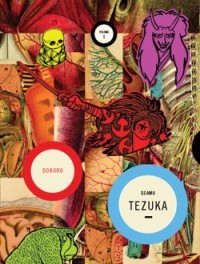
Vol. 1
(by Osamu Tezuka, Vertical, $13.95)
FROM THE BACK COVER:
"Manga-god Osamu Tezuka's shonen-manga classic spawned not only an animated television series in Japan but was also the basis of the PlayStation 2 game Blood Will Tell and a recent live-action adaptation. A supernatural tale of heroism and adventure that has been enjoyed by generations, Dororo is also a subtle allegory of the individual and society's struggle for wholeness in a world ruled by chaos."
EVIDENCE FOR:
(Well gee, Vertical, thanks for not bothering to tell us what the story is actually about. Quick recap: Dororo is a thieving kid who hangs out with Hyakkimaru, a lone warrior with a prosthetic body who must defeat 48 demons to fully restore himself.) If this kind of stuff sounds familiar, it's because Dororo laid the groundwork for many similar series to come: wandering swordsmen, evil spirits, and Defeat X Number Of Villains To Win. But even after all these decades, Tezuka still reigns when it comes to story depth—Dororo and Hyakkimaru don't just go off on an adventure, but they get a solid back-story too, whether it be Hyakkimaru's mysterious beginnings or Dororo's struggle-laden past. The same applies to the characters that they meet: every villager, every troubled soul, is a living breathing example of humanity that you end up caring about. And while the artwork is dated, the basic principles still hold true: line up your panels clearly and use dynamic lines for great action scenes. Go all out with designing monstrous creatures. Put detail and texture into the backgrounds to fill out your fantasy world. Pay attention, kids—shounen manga class is in session.
EVIDENCE AGAINST:
Honestly ... Tezuka's top-tier works have spoiled me. Dororo, although still above average, is a genre-driven potboiler that doesn't really reach the heights that the grand old master is capable of. Instead of looping and twisting storylines, it settles for episodic content, letting Dororo and Hyakkimaru wander from village to village fighting individual demons. Instead of deep reflections on life and humanity and the fate of the universe, it just tries to pile on as much angst and tragedy as possible (seriously, how many mothers and fathers and brothers die in Volume 1 alone?) in hopes of garnering reader sympathy. Even the action gets tiresome after a while, as one realizes that every single one of Hyakkimaru's missions is going to involve slicing up a monster at some point. Dororo may have laid the groundwork for supernatural shounen adventure, but apparently it also laid the groundwork for repetitive, formulaic long-running series.
FINAL VERDICT:
The characters and story are strong, but certain formulaic conventions make it an action-packed B.
GUN BLAZE WEST
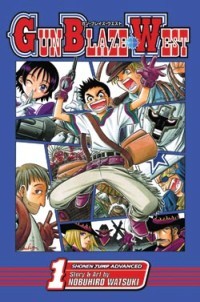
Vol. 1
(by Nobuhiro Watsuki, Viz Media, $7.99)
FROM THE BACK COVER:
"In the Old West only the strong survive. Viu Bannes is a boy on a mission to be the best gunfighter in the West. When Viu meets a vagabond gunslinger named Marcus Homer, his desire to be the best becomes even stronger. He knows it's his destiny to travel to the legendary land known as Gun Blaze West—where only the toughest gunmen dare set foot!"
EVIDENCE FOR:
What do you get when "the Kenshin guy" decides to go all-American? A rip-roaring Wild West adventure! The opening chapters of Gun Blaze West are everything that boyhood dreams are made of: a pistol-wielding kid who longs for adventure, a scruffy outlaw who ends up a hero, and a sneering villain who's only a handlebar mustache short of being the perfect Wild West baddie. Interestingly, the best part of the opening story arc doesn't revolve around Viu himself, but the gunslinger Marcus, who starts out as a petty thief but eventually reforms and ends up being the most influential figure of Viu's youth. Things really hit a high point in Chapter 4, with the beautifully staged gunplay in Marcus's duel against gangleader Bill Kenbrown (the aforementioned sneering villain). Besides that, there are plenty of other eye-catching action scenes—the moment that Viu first fires a real gun in Chapter 1, Marcus and Viu's training montage, and the moment that Viu reaches the goal that Marcus set for him. It's an epic adventure with an epic beginning—and that's probably a good sign.
EVIDENCE AGAINST:
Nobuhiro Watsuki may be good at awakening one's inner 12-year-old boy, but that also means bringing up all the silly, obvious clichés that 12-year-old boys love. We're only one volume in, but this one's already rifling through a whole checklist of plot devices that includes "I gotta get stronger!", a seemingly pointless training exercise, a bold but stupid sacrifice, an item of great destiny, and a time skip in the storyline. (At least it doesn't involve fantasy warriors or the supernatural for once...) And then there's the whole deal with Viu as a 9-year-old being a real brat—he runs around trying to pick fights and generally being an idiot, which is perhaps why Marcus is the more appealing character in this volume. Heck, just looking at Viu annoys me. Must be the eyebrows. But Viu's eyebrows are nothing compared to the flaws of the art style in general—too many lines and not enough tones or shades to set things apart, at least in the early chapters. Things get a little better once Watsuki remembers the importance of hatching ... but it's still pretty hard on the eyes with the blocky, cartoony designs. There's just no room for finesse and gracefulness in the Wild West.
FINAL VERDICT:
The story has its moments with the Marcus arc, but with Viu's great adventure taking shape in such a predictable (and awkwardly drawn) manner, this is only a C at best.
KANNAZUKI NO MIKO
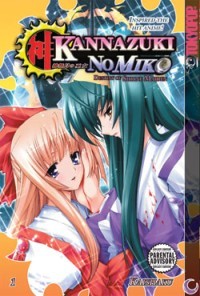
Vol. 1
(by Kaishaku, Tokyopop, $10.99)
FROM THE BACK COVER:
"Shy Himeko adores Chikane, the gorgeous and cool 'princess' of their exclusive boarding school. She's been looking forward to their join sweet sixteen birthday party for weeks. But on that fateful day, a shrine appears in the sky, giant robots ravage the school, and Himeko discovers that she is the reincarnation of the Solar Priestess—and Chikane is the reincarnated Lunar Priestess. As dark secrets unravel, one thing is clear: their lives will never be the same..."
EVIDENCE FOR:
No matter where your tastes lie, Kannazuki no Miko has you covered. Schoolgirls! Ancient legends! Giant robots! Hot lesbian kisses! And really, that's what makes the story a winner: it takes all this fate and legend and adventure stuff and ramps it up to an epic scale, to the point where you have villains hanging around on the moon and robots tearing up the countryside. Everything just feels bigger and grander, and it works. In fact, the mecha in this series are particularly striking in their design—not because they're sleek or futuristic, but because they're so huge and imposing, like great stone giants that have come to life to fight over the fate of humankind. But if you're more interested in the "human" part than the "fighting" part, then this story works well in that mode too; the first volume is really more about the conflicted relationship between Himeko and Chikane than about epic magical battles. Despite their stereotypical personalities, they really do end up as a believable pair—even if the bond between them is shattered in a heart-stopping cliffhanger...
EVIDENCE AGAINST:
I'm sorry, but the only bond going on between the main characters is bi-curious schoolgirl lust. The ill-fated romance in this story is emotionally shallow at best, with everyone throwing generic professions of love at each other. And if it's not generic professions of love, then it's generic declarations of battle when the members of the Orochi make their move. (Seriously, "Sparkling Solar Wave of Ultimate Destruction"? I've seen better in the Tokyopop Rising Stars contest.) What it comes down to is that this series is aiming for grandiosity by trying to pack in every genre, but it's not doing any of those genres particularly well, so you get this really silly-sounding story about robots fighting each other because of an ancient snake god while a couple of shrine maidens go for some suggestive girl-on-girl action. The artwork doesn't really rise much above mediocrity either: the robots, despite being imposing, all appear to be colored the exact same shade of gray. The character designs are pretty forgettable too, and thanks to the "screentone everything in sight" visual style, the action scenes are near impossible to follow.
FINAL VERDICT:
It's grand, it's epic, it's got girls kissing each other, but it's also kind of a mess, so this one ends up with a C+.
MUHYO AND ROJI'S BUREAU OF SUPERNATURAL INVESTIGATION

Vol. 4
(by Yoshiyuki nishi, Viz Media, $7.99)
FROM THE BACK COVER:
"Is there a ghost you need sent up and away ... or down to burn for all eternity? If the answer is yes, then you need Muhyo and Roji, experts in magic law. Serving justice to evil spirits is their specialty.
Muhyo and his friends reach the bottom level of the prison Arcanum, where Face-Ripper Sophie awaits in disguise. Our heroes must locate the real Sophie, but they'd better find her before she gets to them first!"
EVIDENCE FOR:
It's been a pleasant surprise watching Muhyo and Roji improve with each successive volume, and Vol. 4 hits plenty of right notes as it digs further into the series' most involved storyline yet. The chase to catch Face-Ripper Sophie is a near-perfect implementation of the race-against-time formula, and nothing ups the tension level like hearing "Actually ... the killer is one of us." Eventually they come face-to-face with Sophie, and Roji's writing out spirit wards like no tomorrow, and Muhyo is trying to finish a spell that normally takes several people at once—that's pure exhilaration right there, folks; that's the action-adventure genre at its height. But there's a sensitive side to this story arc too, with a bittersweet master-and-apprentice relationship and a heartbreaking betrayal in store for these side characters. Story isn't the only part that's improved, either: the artwork comes alive with fantastic monster designs and detailed backgrounds. If you ever wanted a spirit world worth believing in, this one is a fine choice.
EVIDENCE AGAINST:
For all its improvements since the early chapters, Muhyo and Roji still falls victim to a number of recurring mistakes—the worst being the confounding scene changes. This usually happens when multiple storylines are going on in different locations: let's say Yoichi is off investigating one thing, then it cuts to Muhyo doing his business, and then back to Yoichi, and you have no idea what just happened because the scenes tend to switch in really odd spots with no visual cues. This tends to happen with flashbacks too, though at least you can tell when it's a flashback (solid black behind the panels); but even so, these interstitial scenes break up the story action at the worst possible time. Confusion also results from too many characters running round, most notably during the chase for Sophie. And speaking of characters, I don't think the character design style is ever going to grow on me—they just look too squat and childish a lot of the time.
FINAL VERDICT:
The current story arc continues to reach new heights in terms of battle action and character depth, but some critical mistakes still make it a B-.
SUZUKA
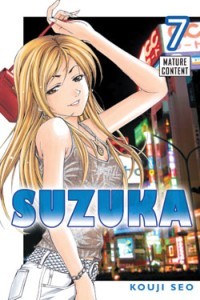
Vol. 7
(by Kouji Seo, Del Rey, $13.95)
FROM THE BACK COVER:
"It's Honoka's birthday, and Yamato wants to find the perfect gift. Since Yamato is absolutely clueless about shopping for a girl, he recruits the reluctant Suzuka to help him. But Yamato's plan unexpectedly backfires where Honoka catches a glimpse of Yamato and Suzuka shopping together. Now the jealous Honoka is convinced that Yamato still has feelings for Suzuka. Will Honoka forgive Yamato, or could this be the end of their tumultuous relationship?"
EVIDENCE FOR:
Guess who breaks up in this volume! Okay, so the next chain of events in Suzuka is a dead giveaway, but they're still a good old punch in the emotional gut. Yamato's nighttime chat with Honoka is a real heartbreaker of a scene, with the dialogue and pacing coming together perfectly to make it feel like ... well ... exactly what teenagers do when they fall in love and say dumb things. In fact, it seems that everyone's wearing a conflicted heart on their sleeve right now: witness Yamato's harsh words with Honoka, his relationship advice sessions with Miki Hashiba, and of course, the constant bickering between Yamato and Suzuka. It may not be an action series, but it still crackles with energy—mainly from the characters' back-and-forth emotions. Strong facial expressions and gestures also help to bring that out; the key to the artwork here is detail and contrast and clearly defining each scene. So that's how it goes—a well-drawn teen soap opera of boys being boys, girls being girls, and all the drama in between.
EVIDENCE AGAINST:
Well, I'm kind of glad that Yamato and Honoka have finally been put out of their misery. But for you, dear reader, that just means more misery as you get to watch Yamato wallow in angst for 180 pages! Even worse, the girls in his life keep rubbing it in: Honoka with her weepy behavior, Miki's constant attempts to drum some sense into him, and Suzuka, goodness gracious, how can anyone still be in love with her after the abuse she dishes out? It's just hard to care about the characters when they're all like this. True, there are some strong emotional moments in this volume, but there are also long stretches of inane dialogue and self-flagellation that basically amounts to: "Yamato, you're an idiot, please stop acting like one." Only in the last scene does Yamato really have a new change of attitude—and by then it's too late, because he's already spent the entire volume going nowhere with his relationships. What a waste of time, watching this guy develop a unique kind of "reverse harem" where he's surrounded by a bunch of hot girls who hate him.
FINAL VERDICT:
The pretty drawings and heartfelt scenes are nice, but with the plot going nowhere and the characters all being asses to each other, that's C behavior right there.

SPY GODDESS
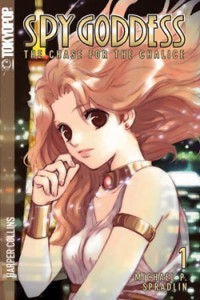
Vol. 1: The Chase for the Chalice
(by Michael P. Spradlin, Rachel Manija Brown and Rainbow Buddy, Tokyopop, $9.99)
FROM THE BACK COVER:
"Spy Goddess Rachel Buchanan is kicking butt, manga-style. Blackthorn Academy is sending her and her friends on their next mission—to Japan. But can Rachel handle her spy assignments: 1) taking down Blankenship's Band of Ninja assassins and 2) surviving as a brassy, sassy American girl in Tokyo? And is that 'tension' between Rachel and Alex something [her best friend] Pilar should start worrying about? Better make time for assignment 3) repeating the phrase: 'I do not have a crush on my best friend's boyfriend!'"
EVIDENCE FOR:
There are so many ways that the comic-ization of Spy Goddess could have ended up as a miserable failure ... yet it miraculously manages to dodge most traps. Sure, you get a WASPy teenage secret agent girl—but she keeps the Valley dialect and Hilton-esque behavior to tolerable minimums, and is not nearly as irritating as the similarly themed Totally Spies!. The teen romance aspect also manages to stay low-key, maintaining itself as a cute little subplot that stays out of the main story's way. Then there's the whole "Americans visiting Japan" setup, which could have been ground zero for all sorts of eye-rolling, facepalming Japanophilia—but after the initial rampage through Akihabara and Harajuku, the story stays remarkably focused on the mission at hand. Speaking of which, the actual mission is where it gets really good, dishing out classic secret-agent action with fancy gadgets, martial arts moves, and a well-rounded supporting cast. Clean-lined artwork and appealing character designs make this one easy on the eyes, and by the time the ending hits (Vol. 1 is self-contained), you'll surely be looking forward to the next adventure.
EVIDENCE AGAINST:
It's cute, it's fun, the story actually makes sense ... it's just that there's not enough of it. The characters are introduced way too quickly (what, are we all supposed to have read the novels first?), the first half is loaded with too much filler, the betrayal midway through the volume doesn't feel dramatic enough, and Rachel's final battle lacks energy. You guys know how thin franchise-based Young Adult novels are, right? This is like that, except with even less content. Even the setting and atmosphere feel shallow, with Tokyo being represented by a number of skimpy architectural features that don't even come close to capturing the feel of Japan. And if it's not lazy background art, it's lazy action art—many of the climactic scenes aren't convincing at all, as the characters vaguely attack the bad guys but look more like they're giving them a gentle tap. Oh, and you know that whole "goddess" thing? ... I realize it's canonical, but it's such an out-of-left-field Deus Ex Machina that it has no place in a secret agent thriller.
FINAL VERDICT:
It's a cute, action-packed concept that manages to not be annoying! Now if only they could get some deeper story content and have the artist draw some proper backgrounds once in a while.

Soul Eater: Awesome or not awesome?! Here's a contrary opinion from S.R. who thinks that last column's review was off the mark. Find out where this supernatural adventure series falls short:
SOUL EATER

Vols. 1-6
(by Atsushi Ōkubo, Square-Enix, ¥410 ea.)
Do you like Harry Potter? If so, you may like Soul Eater. Or you may want to pass on this cheap rip-off.
The story centers around three friends: Harry, Ron, and Hermione—*clears throat*—Black Star, Death the Kid, and Maka. Kid is Headmaster Dumbledore's— —Shinigami-sama's son, Black Star is Uzumaki Naruto, and Maka is the strong, pretty female lead. Even though Maka is a tough girl, she still has to cry a lot and be saved by her weapon, Soul Eater.
The three teens train at a special school for wizards ... errrr ... death gods, called Hogwarts. Just like in Harry Potter, Soul Eater's Shibusen School is for teaching amateurs to become pros ... although there don't seem to be many competent pros around. Maka's father is Shinigami-sama's scythe, but he spends far too much time whining or crying. There's a generic Japanese-drawn black man with cornrows who only seems to be good at pretending to fight the kids. Perhaps the most intriguing character in the entire series is Dr. Franken Stein. Awful name aside, he's a scientist, a sadist, and seems to be the only adult who has any sort of grip on reality.
Unlike Harry Potter, the series drips with innuendo: Maka has to learn to "handle" Soul Eater when he's in scythe form. Kid's weapons are two super-obedient bombshells who turn into guns while he pulls on their triggers. Black Star goes through a bizarre training ritual that requires him to dip his fingers in a pot of liquid (and he is specifically instructed to start with just one finger and then slowly increase to two) in order to better control his sexy kunoichi weapon.
The series quickly drowns in traditional shonen flaws.
There are plot holes the size of planets: one witch (who is detected early but for some reason not confronted until way too late) plans on gaining enough power to control the world by releasing the strongest demon who ever lived. She's counting on the fact that he will obey her. Care to guess what happens?
Characters are obsessed with detailing how each and every one of their moves work. Manga authors, take note: when one of your characters begins spouting DDR arrows to move other characters around, we really don't need you to explain the exact mechanism that allows her to.
While it's sad to see, the initial charm fades fast.
Is there a hidden gem of manga you'd like to reveal to the world? Is there a piece of garbage that deserves to be bashed in public? Or is there a title that didn't get a fair grade here, and you want to set the record straight?
Now's YOUR chance to be the reviewer! Write a review of 400 words and include:
- your name.
- Title of manga (and volume no., if applicable)
- Author/Artist
- Publisher
- Briefly describe the story, then explain why this manga is great, terrible, or in between. Be objective, but also be entertaining.
Then send it in to rtoreaders (at) gmail (dot) com. One review will be selected out of all the submissions and will be published in the next column. All types of manga and manga-inspired comickry are accepted, from past and present, from Japan and beyond—what matters is that it's the Reader's Choice! (NOTE: Entries may be edited for formatting and grammar.)
discuss this in the forum (34 posts) |